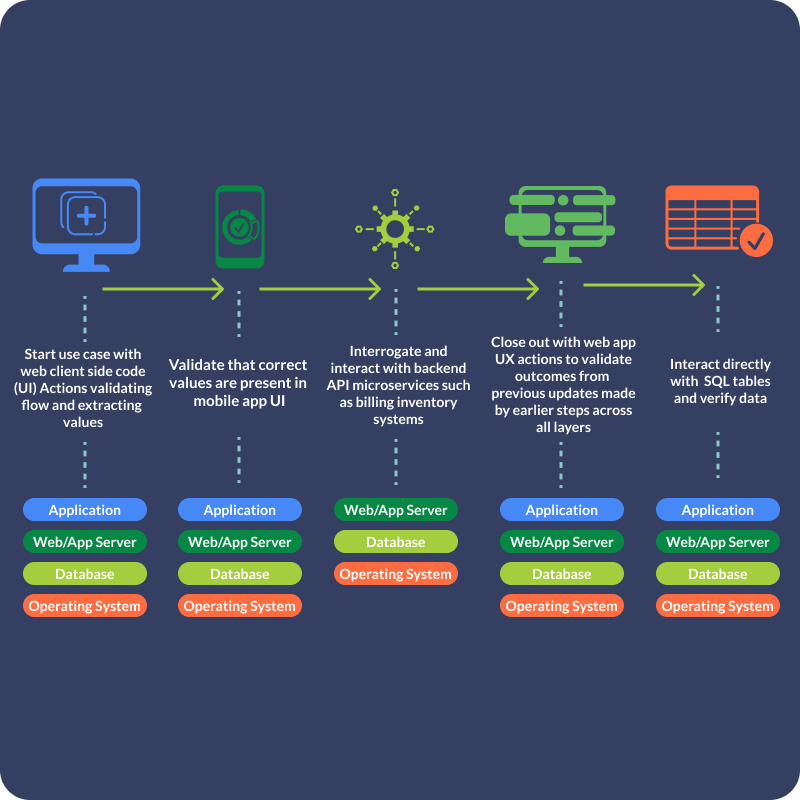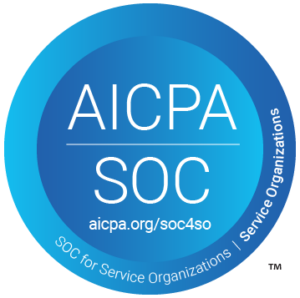Fully Integrated, Low-Code, True End To End System Testing with AIQ Scenario
multiple platforms—web, mobile,
microservices—in one scenario, all without
coding.

Testing That Verifies Your Entire Software Application to
from Start to Finish
End-to-end testing in software testing automation refers to testing a complete application workflow from start to finish, ensuring that all components and subsystems work together as expected. This type of testing validates the entire application flow, including
user interfaces (web and mobile), APIs, backend databases (such as SQL), and any other integrated systems.

The test scenario begins at the user interface level, typically the web interface in the case of a web application. This could involve interacting with various elements on the webpage, such as buttons, forms, or menus.
If the application has a mobile component, the test scenario may transition to testing the mobile interface, ensuring consistency and functionality across different devices and platforms.
End-to-end testing also involves validating the integrity and functionality of the backend database. This includes verifying data persistence, data retrieval, and any data transformations or calculations performed by the application..
Once the backend components have been tested, the scenario may return to the web interface to verify that any changes made during the API or database testing stages are reflected correctly in the user interface.
End-to-end testing often requires the ability to parameterize test scenarios, allowing for the dynamic generation of test data and configurations. This ensures that the same test scenario can be executed with different inputs or environments, increasing test coverage and flexibility.
After validating the user interface, the test scenario may interact with the application's API layer. This involves sending requests to API endpoints and verifying that the responses meet the expected criteria. API testing ensures that the application's backend services are functioning correctly and responding appropriately to requests.
In the case of enterprise applications with complex architectures spanning multiple servers, end-to-end testing involves validating interactions across these distributed components. This could include testing communication between application servers, databases, caching layers, message queues, and other infrastructure elements.
While many test automation tools focus on specific layers or components of an application, AIQ offers comprehensive end-to-end testing capabilities. These tools provide features for orchestrating complex test scenarios, integrating with various technologies and platforms, and facilitating parameterization and data-driven testing.
Benefits
End-to-end testing with practically
100% application coverage and virtually zero risk
End-to-end testing in software testing automation refers to testing a complete application workflow from start to finish, ensuring that all components and subsystems work together as expected. This type of testing validates the entire application flow, including
user interfaces (web and mobile), APIs, backend databases (such as SQL), and any other integrated systems.
Identifies integration issues between different components of the software or between different systems in a complex IT infrastructure. Resolves issues early in the development process, improving the overall quality of the software.
Ensures that all components work together seamlessly, resulting in a smoother user experience.
Minimizes the risk of deploying a faulty software application.
Reduces the cost of fixing bugs that are discovered later in the development process or after deployment.
Automates repetitive tasks, such as regression testing, which frees up developers to focus on more complex and creative tasks.
Ensures that the software can handle increased workload or user load as the business grows.
Experience The Power of Synthetic APM


3080 Olcott Street
Suite B240
Santa Clara, CA 95054
info@appvance.ai (855) 254-1164
3080 Olcott Street
Suite B240
Santa Clara, CA 95054
info@appvance.ai (855) 254-1164

Product
- Autonomous Testing
- Test Creation
- Test Execution
- Test Results
Solutions
- By Technology
- By Use Cases
Resources
Company
Popular Links
- Autonomous Testing
- Test Creation
- Test Execution
- Test Results
© 2023 Appvance Inc. • All Rights Reserved.